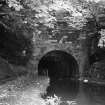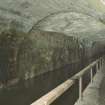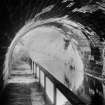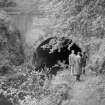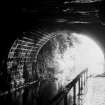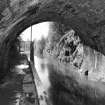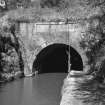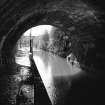Falkirk, Union Canal, Canal Tunnel
Tunnel (19th Century) (1820)-(1822)
Site Name Falkirk, Union Canal, Canal Tunnel
Classification Tunnel (19th Century) (1820)-(1822)
Alternative Name(s) Hallglen Tunnel; Prospect Hill; Prospecthill; Edinburgh And Glasgow Union Canal
Canmore ID 46771
Site Number NS87NE 31.01
NGR NS 88245 78740
NGR Description NS 88141 78983 to NS 88390 78400
Datum OSGB36 - NGR
Permalink http://canmore.org.uk/site/46771
- Council Falkirk
- Parish Falkirk
- Former Region Central
- Former District Falkirk
- Former County Stirlingshire
NS87NE 31.01 88245 78740 (NS 88141 78983 to NS 88390 78400) LIN 18
Tunnel [NAT]
OS 1:10,000 map, 1981.
For corresponding railway tunnel (adjacent to NE), see NS87NE 49.
Not to be confused with new tunnel (NS 85257 79848 to NS 85264 79684, immediately above Falkirk Wheel), for which see NS87NE 31.05.
Location cited as NS 881 790 to 884 784: Scotland's only surviving canal tunnel.
J R Hume 1976.
Built 1818-22, designer Hugh Baird. This 600m long rock-cut tunnel takes the Union Canal through a ridge W of Callendar Park. It is patched with masonry and brickwork and at either end there is a round arch set in a concave masonry facing. The tow-path inside the tunnel has been renovated and provided with a handrail for the use of pedestrians. This tunnel is of some interest in that it is earlier than the railway-tunnels and therefore, presumably, the oldest tunnel in Scotland.
RCAHMS 1963 (visted 1954); J Lindsay 1968.
As William Forbes refused to allow the canal to pass within sight of his property, Callendar House, this tunnel, the only canal tunnel in Scotland, had to be constructed under Prospect Hill. The tunnel, which is 690 yards in length and has a towpath running right through it, has been cut out of solid rock, with deep rock cuttings existing at both ends. There is constant water seepage through the roof.
G Hutton 1993.
The tunnel became a requirement when the 18th century industrialist William Forbes, who had purchased Callendar House, objected to the proposed route of the canal as being too close to his property. Navvies, with the assistance of horses, cut this 690 yard tunnel. In order to have several faces operating simultaneously, three shafts were sunk. The tunnel is 18 feet in width, of which 13 feet is waterway and 5 feet towpath, and the height is 19 feet in total, six and a half feet being water and 12 feet being clearance. A sturdy handrail has been provided for safety, but, due to the darkness, a torch is advisable.
H Brown 1997.
This tunnel is clearly marked on the 1st edition of the OS 6-inch map (Stirlingshire 1864, sheet xxx), on the 2nd edition of the OS 6-inch map (Stirlingshire 1899, sheet xxx NE), on the current edition of the OS 1:10000 map and on the OS Basic Scale digital map (2000).
Information from RCAHMS (MD) 3 May 2001.
This tunnel carries the Edinburgh and Glasgow Union Canal (NS87NE 31.00: LIN 18) beneath Prospect Hill, and was constructed to by-pass opposition from the proprietors of Callendar House (NS87NE 3.00). It was the third canal tunnel in Scotland, two others (NS46SE 492.09 and NS46SE 492.24 ) having been constructed on the Glasgow, Paisley and Ardrossan Canal in 1811. It was also the most spectacular, being cut through solid rock for 696 yards (636.6m) from both ends and from intermediate shafts.
It was intended to create a 13ft (4m) wide waterway with a 5ft (1.5m) wide tracking [tow] path. The roof was to be at least 12ft (3.7m) above top bank level, but could to made higher where unstable rock was removed. Masonry arches were inserted in an area of geological intrusion, some being only constructed after the tunnel had been opened for some years. Dressed rubble masonry was used to build up the tracking path where the rock was unstable.
Each of the entrances was finished with dressed masonry, and lined for a short distance internally.
G Hutton 2002.
This tunnel is striaght on plan, unlined for the most part, of generally square section, and of considerably larger section than most canal tunnels.
The construction shafts are not indicated on the 1961 edition of the OS 1:2500 map, and their location cannot be ascertained from the available (GIS) map evidence.
Information from RCAHMS (RJCM), 2 March 2006.
NS87NE 31.01 88245 78740 (from NS 88141 78983 to NS 88390 78400)
2001 survey photographs stored under 'Union Canal' in the NMRS.
Project (2007)
This project was undertaken to input site information listed in 'Civil engineering heritage: Scotland - Lowlands and Borders' by R Paxton and J Shipway, 2007.
Publication Account (2007)
This was the only canal tunnel in Scotland before completion of the new tunnel at the Falkirk Wheel in 2001. The
necessity for the tunnel, which is just south of Falkirk and 696 yards long, arose from the refusal of landowner
William Forbes to allow the canal to cross his estate in view of Callendar House. A further objection by him also
resulted in a deep cutting north of the tunnel. The tunnel, completed in 1822, is about 1312 ft wide and driven mainly through solid rock. It is unlined but patched with masonry and brickwork in places. At each end there is a masonry fac¸ade with semicircular archring. The work was designed and constructed under the direction of the Edinburgh & Glasgow Union Canal Company’s engineer Hugh Baird and the contractor was John Mitchell. The towpath has been renovated and provided with a handrail for pedestrian safety. Miller had a similar problem at the Falkirk ridge when engineering the Edinburgh & Glasgow Railway from 1838–41 which he resolved by making a tunnel 846 yards in length just to the north-east of the canal tunnel.
R Paxton and J Shipway 2007
Reproduced from 'Civil Engineering heritage: Scotland - Lowlands and Borders' with kind permission from Thomas Telford Publishers.


















